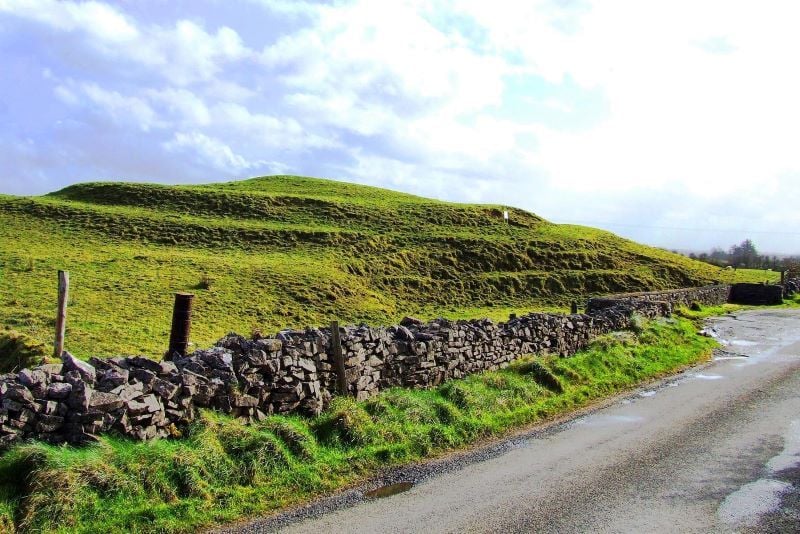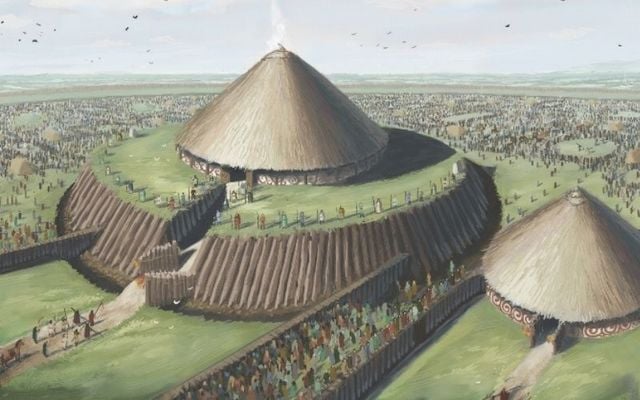Most tourists, both Irish and international, will be unfamiliar with Rathcroghan in County Roscommon, but it used to be the ancient royal capital of Connacht.
With over 240 ancient monuments in the area, Rathcroghan is “one of the most important prehistoric and early medieval landscapes in all of Ireland," according to Daniel Curley who manages the site's visitor center in the nearby town of Tulsk.
The site includes a wide array of prehistoric monuments, including burial mounds, ringforts, temple sites, and even a ritual gate to the otherworld, described as Ireland's "Gate to Hell."
At least 28 of the monuments are more than 5,000 years old and date back as far as the Bronze and Iron Ages.
The Cattle Raid of Cooley, one of the most famous pieces of Irish mythology, also began at Rathcroghan.
However, while the sites at Newgrange and Tara continue to draw large volumes of tourists, Rathcroghan remains largely forgotten.

Rathbeg, Rathcroghan, Co Roscommon. (Ireland's Content Pool)
Curley has a simple explanation for this. He said that Rathcroghan, like many other areas west of the River Shannon, was neglected while Newgrange and Tara were being renovated.
“While ground-breaking research and excavation were being conducted on the great sites of Co Meath from the 1960s onwards, Rathcroghan was largely forgotten until relatively recently,” he said to the Irish Times. “Anything west of the Shannon tends to get ignored, particularly in Roscommon and east Galway.”
Rathcroghan, however, is beginning to realize its potential as a huge tourist attraction and numbers have been steadily rising over the past few years.
The growth has been remarkable considering the site has had precious little help from Failte Ireland, Ireland's national tourist authority.

Love Irish history? Share your favorite stories with other history buffs in the IrishCentral History Facebook group.
Instead, it has taken a community effort to propel Rathcroghan to national attention.
Locals are well aware of the tales from the prehistoric site and grew up learning about how Queen Maeve from Irish mythology had her seat at Rathcroghan and they wanted to share this knowledge with the rest of the world.
In 1999, the community built a visitor center to celebrate the local folklore, but funding was poor and it resembled a shed bedecked with uninspiring information displays.
Consequently, Rathcroghan never really drew tourists like a site of its historical prominence should have been doing.
Yet, something began to change about five years ago. Word began to spread about a hidden gem located out west and numbers began to grow.
As a result of this increased interest, the visitor center received funding to improve the information displays which precipitated more growth, according to Curley. He said that the information in the visitor center is all based on local knowledge and research.
“We received some funding to renovate the information displays at the center,” says Curley. “This chance to retell the story in our own words, based on our own research and our interpretation of the latest scientific investigations was like a jolt of adrenalin.”
After the information boards were improved, locals began to seek funding to renovate the center's exterior, along with the cafe and shop, which increased growth further.
"Each improvement led to more tourists coming through the doors and the impact was dramatic: between 2015 and 2019 visitor numbers rose from 9,000 to 22,000."
With the help of a skillful tour guide, Rathcroghan is a window into Ireland's prehistoric past.
Take a look at the new video welcoming you to our website and highlighting our tours and facilities at Rathcroghan. Our thanks to Fáilte Ireland Ireland's Hidden Heartlands and Mimar Media for making it happen. #TourRathcroghan #FáilteIreland #irelandshiddenheartlands #mimarmedia #keepdiscovering
Posted by Rathcroghan Visitor Centre on Thursday, September 23, 2021
The untrained eye, for example, would miss the entrance to the otherworld, known as Oweynagat Cave, which appears to be nothing more than a small hole in a field.
However, once you crawl inside it, you can see the carved Ogham stone at the gate's entrance and a long tunnel that leads to a huge limestone fissure beneath the earth.
Guides can also point out the Rathcroghan Mount, known locally as Queen Maeve's Fort. With parade ramps and enclosures for visiting dignitaries, experts believe that the fort was used for hugely significant ceremonies, including burials and coronations.
The ancient site at Rathcroghan is one of the most fertile lands in the west of Ireland and that has led to the remarkable preservation of the site over the course of five millennia, according to Curley.
“The traditional farming methods practiced here meant the remains have been remarkably well preserved, so you can actually see in the landscape scenes described in these Iron Age tales,” he said.
The ancient site is not only benefitting tourism in the area, however, and it is also heavily influencing local farming.
The area is on its way to becoming the first area in Ireland with its own EU-recognized designation as a re-established Iron Age farming landscape through environmentally sustainable farming.
Farmers in Rathcroghan aim to produce fruit, meat, dairy products, and vegetables in a similar manner to our prehistoric ancestors in order to make farming more attractive to younger generations.
The European Innovation Partnership gave the area €1 million to make the area more sustainable over the next five years and farmers are already started to change the way they farm.
Farmers have installed fencing around the historic ringfort to prevent cattle from grazing on the ancient fort, while some farmers have swapped European breeds of heavy cattle with smaller native breeds.
One farmer plans to re-introduce an almost-extinct breed of Irish sheep back into the Roscommon ecosystem.
The biggest issue will be convincing farmers to abandon slurry tanks and chemical sprays in favor of more traditional farming methods. However, Curley believes that it is possible.
“It’s about thinking outside the box, getting people to imagine a different future.
"I’m certainly not promising it’s going to be easy, but the opportunities to create something truly world-class here in Roscommon is palpable. It just requires us to work together.
“We’ve got this far as a community, who’s going to stop us now?”
*Originally published in April 2020. Updated in Nov 2024.




Comments